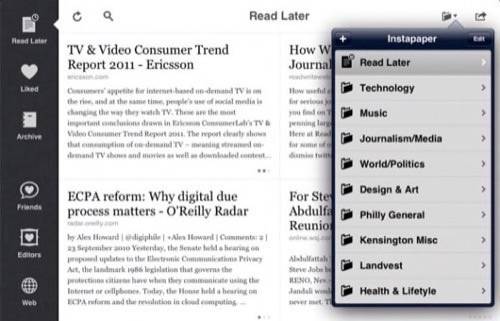People didn’t understand the iPad immediately. No one believed in the form factor. “Just a big iPhone,” people called it. But it caught on, it took off, and now consumers can’t let go of their tablets. The intimate, intuitive interface has created its own use case. People curl up with the device and they read.

Publishers and app developers have provided a bonanza of ways to read on the iPad and iPhone. Some are free, some cost money, some require monthly subscriptions. All of them are vying for your attention in that new, valuable hour or two of tablet time in the evenings. But one app, Instapaper, sits in the iPad Hall of Fame on iTunes, pushing forward reader behavior just like the iPad itself. Marco Arment, creator of Instapaper, answered some questions for us about where this is all heading.
It’s An iPad Market
At this point, Apple’s lead in tablets is daunting. At a base price of $499, the 9.5-inch iPad and the devices it inspired are even encroaching on the bottom end of the PC market. Apple’s “post-PC world” rhetoric is projected to be surprisingly prescient.
But there seems to be room below the iPad in the market. Surveys found consumers clamoring for a cheaper tablet, and Apple competitors have begun to deliver. Amazon announced the 7-inch, $199 Kindle Fire in September, and in response Barnes & Noble unveiled a $249 Nook Tablet yesterday with twice the memory and storage space of the Fire.
The Amazon and Barnes & Noble tablets are geared towards consumption, as one would expect from two companies whose businesses were built on selling books and music. Apple is in the content business as well, though it positions the iPad to be for much more than that. Even so, consumption, specifically reading, of quality content has been reborn on the iPad.
“The iPhone, and especially the iPad, have brought a fundamental shift to the publishing business: it’s now very easy for customers to pay for apps and content directly, with small amounts of money, in large volumes.” — Marco Arment
The Reading App Gold Rush
Developers have built all kinds of applications to deliver the ideal iPad reading experience, and Big Publishing wants in on the action. Flipboard publishers now show magazine-style full-page ads, and Zite was bought by CNN. AOL made Editions, Yahoo made Livestand, Google’s making Propeller, all to do the same thing. It’s a gold rush.
Publishers are even building their own apps now, and the new iOS 5 Newsstand provides a home for them. The Guardian iPad edition launched the same day as iOS 5. The New Yorker iPad app has surpassed 100,000 readers. These are first-rate iPad experiences, not just crumpled Web views, and they’re finding traction as subscription publications.
Instapaper’s Content Shift

But one $5 app, not affiliated with any publishers, showing no advertisements, requiring no “monetizing” other than its modest price tag, and created by one person, has remained near the top of the heap of iOS reading apps all along. Instapaper continues to introduce iPad and iPhone readers to the notion of content-shifting, saving one’s daily Web reading with one click, so that it can be read later from one sparse, quiet place, even offline.
Really, Instapaper can be read in three places; anyone can use Instapaper.com from her or his desktop, tablet or smartphone. But it’s also a universal $5 app for iPhone and iPad, and the release of Instapaper 4.0 last month redesigned the experience as the self-curated, instant newspaper for iOS 5.

Arment recently answered a few questions for us about Instapaper, iOS and the future of reading:
ReadWriteWeb: Do you think about the big picture for Web content, or is that not really your concern?
Marco Arment: “I want Instapaper to be a tool that people use to read longer pieces, and more attentively, than they otherwise would have. By doing this, I hope to make it more feasible for publishers to maintain an audience while publishing articles more substantial than what we usually see on formulaic high-volume blogs.”
RWW: What are your plans for Give Me Something To Read?
MA: “Give Me Something To Read serves Instapaper very well as a curated list of the best long-form nonfiction writing and reporting. My plans are to keep it going, really — it’s exactly where I want it to be.”
RWW: You said recently that you don’t like to emphasize the offline part of Instapaper. Why is that? Isn’t that a distinguishing feature?
MA: “It’s certainly a very good and useful feature, but it’s not a feature that a lot of people know that they need, so they aren’t looking for a solution to that problem. Once they have Instapaper, it’s a feature that most customers use and benefit from very often, but it’s not a very good selling point.”
RWW: Is iOS changing the way we read at a platform level? The great RSS readers have some of their most compelling apps ever on iOS, and the competitors in the publishing biz are there, too. Even major content sites (like The Guardian) are starting to put save-for-later functionality into native apps. Is the nature of the whole platform responsible for this? Or have you just inspired everyone?
MA: “The iPhone, and especially the iPad, have brought a fundamental shift to the publishing business: it’s now very easy for customers to pay for apps and content directly, with small amounts of money, in large volumes. This wasn’t (and still isn’t) practical on the web. And with the rising popularity of iOS, many millions of people are devoting more of their computing time to devices that are much better suited for reading than desktops and laptops.

“These two shifts, more than anything, have brought new life to the publishing business, from big newspapers and magazines to individual bloggers, by increasing demand for content and making it easier to make money without wedging ads everywhere.
“Instapaper and its various clones help bridge the web and iOS worlds. There’s relatively little competition only because it’s a very new problem that the mass market has yet to realize that they have. It’s not just “read later”, but “read elsewhere” – most people would prefer the reading experience on an iPad to a web browser on a PC.”
The iPad And The Couch
Instapaper is not the only cross-platform content-shifting app out there, and we’ve argued that all tablet reading apps should have the feature. The Guardian’s new iPad app does.
But the single content-shifting app, – like Instapaper or Read It Later – pulls all the day’s articles into one familiar place, like the iPad’s equivalent of the couch on which we read it. That’s the most important part of the future of content, which the ad-riddled Web is only just starting to understand: the experience.
Marco Arment is the creator of Instapaper. He also blogs about technology (and coffee) at Marco.org, and he hosts Build & Analyze a weekly news and discussion show about iPhone, iPad, iOS and mobile Web development with Dan Benjamin on 5by5. Follow him on Twitter @marcoarment.
Do you use any content-shifting apps for your daily reading? Share your digital reading habits in the comments.









